UC Gardening Blogs
Hey, Honey Bee, I'll Race You to the Flowers!
Hey, honey bee, I'll race you to the flowers. Okay, but you'll lose. I can go faster. Watch...
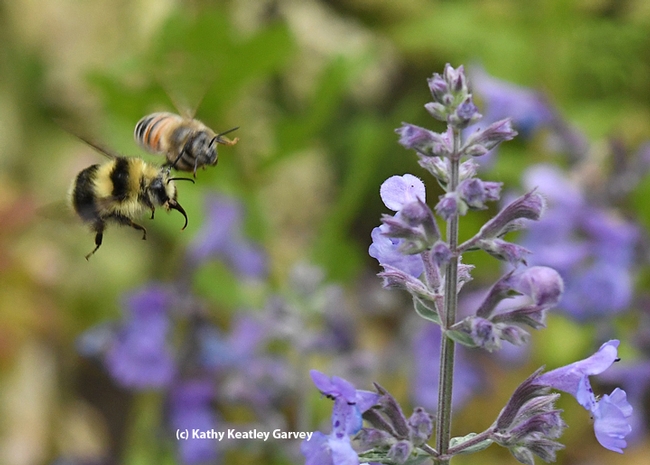
A honey bee and a bumble bee, Bombus melanopygus, head for the same patch of lavender. This image was taken in Vacaville, Calif. (Photo by Kathy Keatley Garvey)
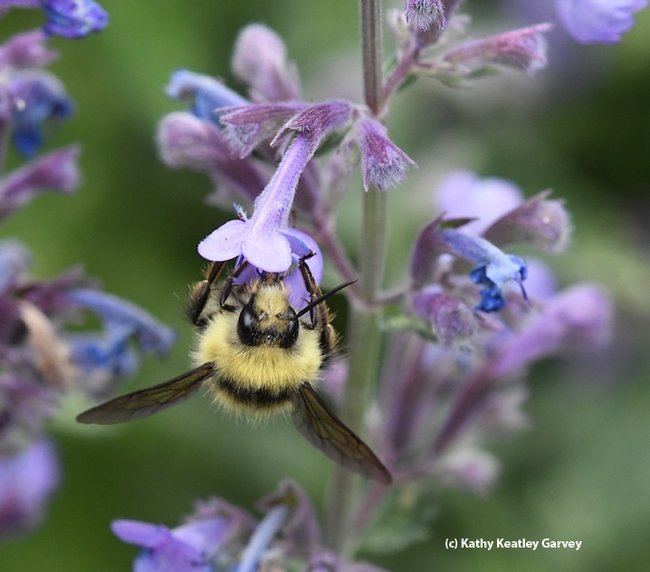
The bumble bee, Bombus melanopygus, sips nectar from a lavender blossom. (Photo by Kathy Keatley Garvey)
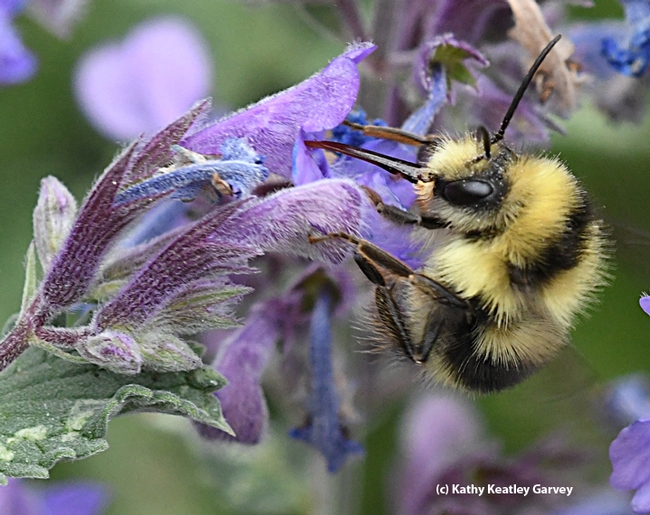
In this photo, you can see the bumble bee's tongue or proboscis, as it sips nectar from lavender. This is a male Bombus melanopygus. (Photo by Kathy Keatley Garvey)
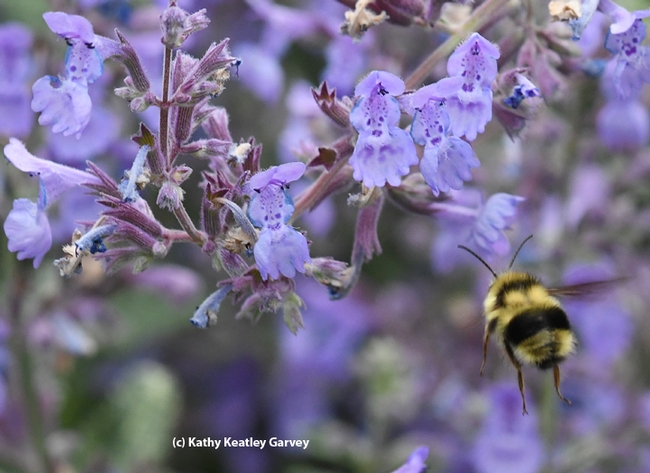
It's off to another blossom. A male bumble bee, Bombus melanopygus, heads for more nectar. (Photo by Kathy Keatley Garvey)
From My Garden to Yours
The days became so hot very quickly and basically fried my rose blooms to a crisp! We had such nice cool weather as the roses went through their first bloom flush and then ZAP: crispy roses, anyone? The hot weather put a stop to my all day pruning and cutting away from the fence in preparation for the building of the new fence. WOW, I hasn't been drinking so much water in a long time, nor sweating so much since I retired. Glow, heck; I just sweat! Time for a break . . .
One of the more interesting questions from the Vallejo Farmers' Market went something like this: “My husband and I have a real disagreement about growing tomatoes. He swears that the first blooms should be removed after transplanting; I don't. Can you tell be something to make him stop?” Now I am not going to step into that one, but I did suggest they compromise: deflower half of the tomato plants, leave the rest alone, and see which plants grow and fruit the best. Sorry, but he'd already done all of the plants, that was a moot point. I told her I'd look it up at home and if she came back to the booth, I might be able to give her some answers.
My first thought was which tomato plants they bought: determinate or indeterminate. This would make a difference as the determinate varieties of tomatoes will produce just so many flowers during the plant's lifetime. The indeterminate tomatoes will continue to bloom and produce up until the frost or even beyond according to one home grower. Picking off flowers from the determinate plant will lessen the total yield; therefore you just might be shorting yourself some fruit.
On the other hand, pinching off flowers can help the tomato plant develop stronger root systems according to the pro-pinch side. However, that deflowering is done BEFORE transplanting into the garden; loss of pollination and fruit time can occur if the blooms are removed AFTER transplanting. Another reason for pinching is if you plant your tomatoes early, there may no pollination taking place, those flowers will not produce and take energy from the plant that could go into developing stems, leaves, and roots.
If, however, you buy tomato starter plants when the warm weather is here, it's advisable to leave the flowers on the plant; if weather has been hot/cool/hot cool, we want to have as long a growing period as possible to give the fruits time to fully ripen. Then too, leaving the flowers on the plants helps the plants the time of starting to bloom again; just plant these plants a little deeper into the soil, removing the bottom 3 sets of leaves and putting that area of the stem below the soil line. This will help put the original roots well into the soil and “tells” the buried portion of the stem to grow additional roots.
So if that woman comes back on Saturday, I'll hand her the information I found online and she can discuss it at home. It appears that either way works, and that's what counts!
Did anyone read their new copy of SUNSET MAGAZINE yet? Kudos to Rose Loveall for the wonderful article on Morningsun Herb Farm! Wonderful article starting on page 54 (June issue).
No Good Deed Goes Unpunished
[From the UC Weed Science blog] In what has been dubbed “dandelion-gate,” members of...
Huckleberries and Serviceberries
I recently returned from vacationing at Yellowstone National Park, both on the Montana and Wyoming sides of the park. Although the park is infinitely fascinating and I strongly recommend that everyone visit at least once, the topic of this blog pertains to another well-known and beloved mainstay in the area known as the huckleberry (the two most popular varieties being the globe huckleberry and the big huckleberry known as Vaccinium globulare and Vaccinium membranaceum, respectively). Although residents of Montana and Wyoming may cringe or disagree with this characterization, to this native Californian, wild huckleberries taste much like the blueberries to which we are accustomed (indeed, a restaurant employee of a park concessionaire said to me that to him, the huckleberry was essentially a “mountain blueberry”). Big and globe huckleberries are usually picked from May to July in the mountains where elevation stands between 3,500 and 7,200 feet. They tend to establish themselves years after a fire has swept through an area. The harvesters of such fruit even have a unique name—they are called "huckleberriers." A few years back, huckleberries were selling between $35-40 a gallon. Huckleberry products line the shelves of gift stores and supermarkets in Montana and Wyoming. As with most berries, huckleberries can be made into syrup, used in baked goods and ice cream, preserves and salad dressings.
Although we cannot experience true huckleberries locally apart from ordering products on-line, the closest thing we have to it here is a perennial shrub called the serviceberry aka shadeberry, Juneberry, or Saskatoon (Family: Rosaceae; Genus: Amelanchier). Service berry plant starts can be found at well-stocked nurseries in the Bay Area. It is my understanding that the serviceberry is an easier plant to grow than blueberries, and may be a prolific producer under ideal conditions starting in year 2 (shrub grows to 3' tall and will send out runners). If you are a berry enthusiast, consider the serviceberry for your garden.
Tower of Beauty: Tower of Bees
The Echium wildpretii is commonly known as "The Tower of Jewels" but it ought to be known as "The...
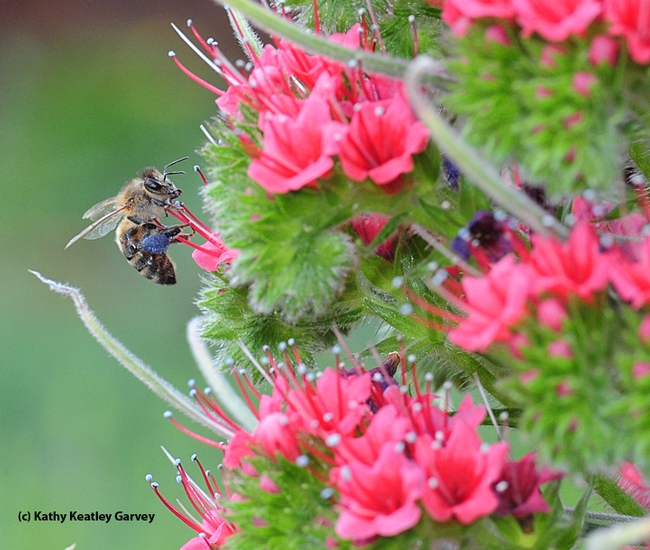
A honey bee packing blue pollen as it forages on the tower of jewels, Echium wildpretii. (Photo by Kathy Keatley Garvey)
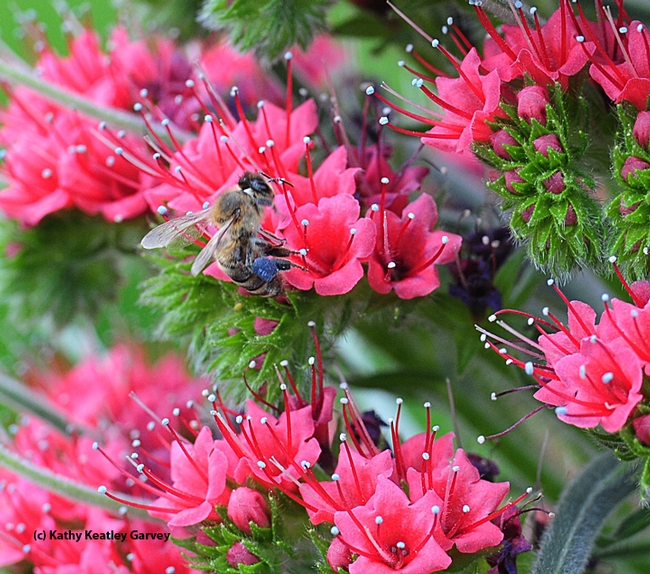
This foraging honey bee can't get enough of the tower of jewels, Echium wildpretii. (Photo by Kathy Keatley Garvey)
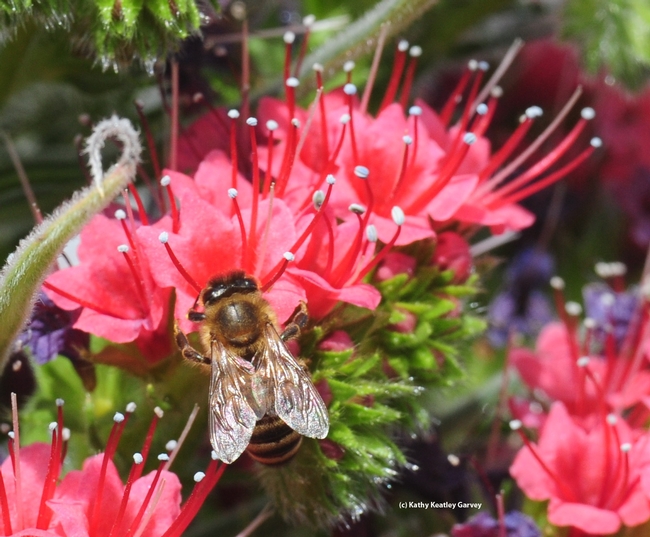
Honey bee wings glisten in the early morning sun. The tower of jewels is sometimes "the tower of bees." (Photo by Kathy Keatley Garvey)



